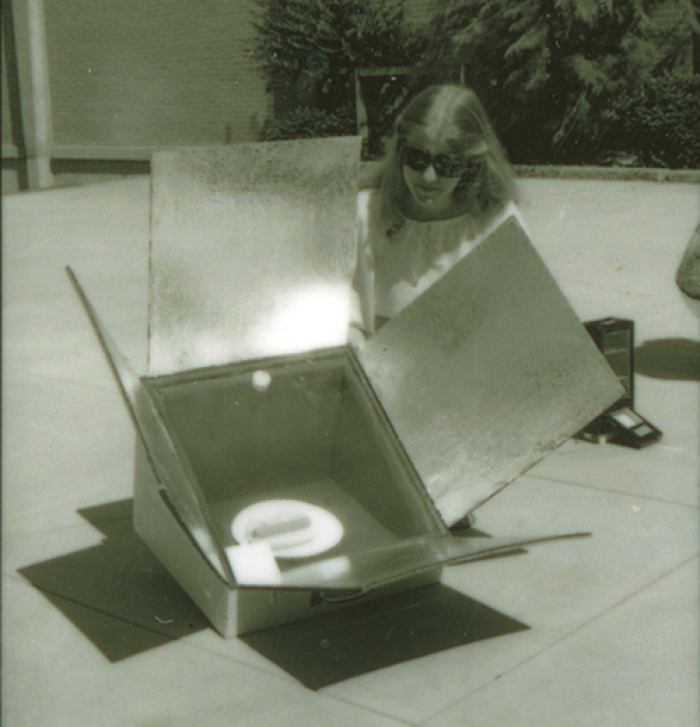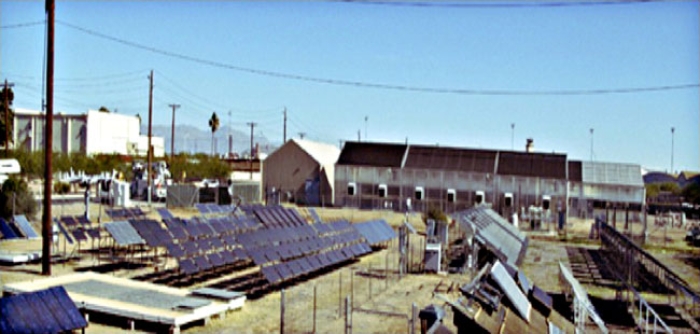On April 25, 1954, Bell Labs announced its latest invention, a silicon solar cell, at a press conference in Murray Hill, New Jersey. A hush fell over the audience during a demonstration of the nation’s first solar panel, used to power a toy Ferris wheel and a radio transmitter.
The breakthrough made national media headlines, with The New York Times reporting that the silicon solar cell “may mark the beginning of a new era, leading eventually to the realization of one of mankind’s most cherished dreams — the harnessing of the almost limitless energy of the sun for the uses of civilization.”
The dream of harnessing the sun’s limitless energy took root 2,000 miles away at Arizona State University that year. Visionaries Farrington Daniels, a University of Wisconsin researcher, together with Arizona business owners Henry Sargent, Walter Bimson and Frank Snell, founded the new Association for Applied Solar Energy, a nonprofit scientific and educational organization headquartered at ASU.
With an average of 300 sunny days per year, the Valley of the Sun proved to be the ideal location for advancing solar-powered energy.
Today, more than 160,000 solar installations in Arizona produce enough energy to power more than 768,000 homes. With prices falling 38% over the last five years, solar energy is becoming more cost effective and widespread. ASU’s solar program provides more than 50 MWdc equivalent solar-generating capacity, which contributed to the university reaching its goal of becoming carbon neutral in 2020, with zero greenhouse gas emissions from campus operations.
Here, we chronicle some of the major milestones in the history of solar energy development at ASU, revealing how the university has emerged as a national leader in the field.
All photos from ASU Archive
1955
First Solar Energy Symposium draws international leaders
The World Symposium on Applied Solar Energy features presentations by an international cast of thought leaders in an event that draws 130 delegates from 36 countries and spotlights solar’s issues and applications. The event is co-sponsored by the Association for Applied Solar Energy headquartered at ASU.
1956
ASU installs first solar furnace
A groundbreaking structure featured in Time and Life magazines, the solar furnace uses mirrors to concentrate light on a focal point, generating high heat used to make electricity.
1972
Advancing research with one of the nation’s largest solar energy library collections
ASU’s Hayden Library houses one of the largest solar energy library collections in the country since 1972, including one-of-a-kind reference materials published by the International Solar Energy Society.
1974
Preparing the next generation of solar energy professionals
ASU’s College of Architecture leads the nation as the first program to offer a master’s degree focused on solar applications.
1975
Fueling Arizona’s solar energy development
Arizona Gov. Raul Hector Castro establishes the Arizona Solar Energy Research Commission, which empowers state institutions, businesses, universities and local governments to successfully obtain federal support for solar energy development.
1983
ASU opens first solar demonstration facility
The university launches a facility that demonstrates active and passive solar energy conservation features and serves as a research center for scientists conducting solar strategies testing.
1992
Building a more efficient solar energy cell
ASU launches the Photovoltaic Testing Laboratory, where faculty, staff and students test and certify photovoltaic module reliability, durability and performance while forging key partnerships within the solar energy industry.
2004
ASU’s first solar system saves energy and provides shaded parking on Tempe campus
ASU’s first solar power system is installed on top of the Tyler Street parking structure. The 34 kWdc system provides enough energy to power the entire structure’s lighting and shades 44 parking spaces.
2006
Setting the state standard for generating solar and other renewable energy
Arizona Corporation Commissioner and ASU Professor Kristin Mayes helps co-author the Arizona Renewable Energy Standard and Tariff (REST), which requires utilities to generate 15% of their overall energy portfolio from renewable sources such as solar, wind, biomass, biogas and geothermal by 2025.
The Arizona Renewable Energy Standard and Tariff generated approximately $2 billion in economic benefits in the state through energy and water savings, reduced carbon emissions, decreased technology costs and increased renewable energy investment between 2008-18, according to an estimate by California-based consulting firm Strategen.
2008
Solar Power Laboratory boosts Arizona energy industry
ASU launches the Solar Power Laboratory to advance solar energy research, education and technology. Christiana Honsberg and Stuart Bowden, experts from one of the nation’s leading solar energy research programs, join ASU to lead the laboratory. Initial funding to create the lab comes from Arizona’s Technology and Research Initiative Fund (TRIF), part of a voter-approved sales tax increase to support education in the state.
TUV Rheinland partners with ASU on new solar energy facility
TUV Rheinland Group joins forces with ASU to create TUV Rheinland PTL, the most comprehensive, sophisticated, state-of-the-art facility for testing and certification of solar energy equipment in the world. The powerful duo combines the stellar reputation, technological sophistication, management expertise and international reach of TUV Rheinland — a global leader in independent testing and assessment services — with ASU’s more than 50 years of research on solar energy and extensive solar testing abilities.
2009
ASU’s Energy Frontier Research Center opens
Sponsored by the U.S. Department of Energy, the ASU center pursues advanced scientific research on solar energy conversion based on the principles of photosynthesis. The goal is to accelerate scientific advances needed to build a 21st-century energy economy.
2011
Engineering Research Center launches to accelerate solar energy development
ASU launches the Quantum Energy and Sustainable Solar Technologies (QESST) ERC with $18.5 million in funding from the National Science Foundation and Department of Energy. QESST provides a staging ground for major innovations in solar energy devices and systems, supported by ASU’s state-of-the-art Solar Power Lab. The center forges industry partnerships that accelerate commercialization of solar energy technologies and expands energy engineering education options.
Downtown Phoenix and West campuses install first solar power systems
ASU expands its solar capacity by installing a 77-kWdc system on the roof of the Walter Cronkite School of Journalism and Mass Communication building and 322 solar panels on the ASU West campus.
2012
Commanding the lead in solar energy
ASU’s Tempe campus, with 74 solar systems, has the largest solar energy capacity of a single university nationwide. Collectively, photovoltaic and solar thermal installations on ASU’s four campuses generate 23.5 MWdc of energy as of 2012, avoiding 21,991 metric tons of carbon dioxide equivalent emissions per year.
2017
Numerous ASU solar innovations go to market
In 2017, QESST creates three new student- and alumni-based spinout companies (bringing the total to eight), one of which set a NREL-certified solar cell efficiency record. ASU’s solar patent portfolio expands from 18 to 22 provisional or full patents, while QESST alumni work as scientists, engineers and policymakers in 54 different technology firms, national labs and other energy related fields.
2018
ASU solar engineers break solar cell record two years in a row
Assistant Professor Zachary Holman and Assistant Research Professor Zhengshan “Jason” Yu in ASU’s Ira A. Fulton Schools of Engineering set a world record of 23.6% efficiency for a tandem solar cell stacked with perovskite and silicon in 2017. The number was a few percentage points shy of the theoretical efficiency limit for silicon solar cells alone.
A year later, the team improves upon the record by nearly two percentage points, to 25.4%, in a joint project with researchers at the University of Nebraska – Lincoln. The team predicts they’ll be nearing 30% tandem efficiency within a few years.
ASU radiant with solar cell research awards
ASU earns six prestigious Department of Energy awards, totaling nearly $5.7 million, ranking it first among university recipients of Solar Energy Technologies Office (SETO) awards to advance photovoltaic research and development in 2018.
SETO funds early-stage research projects that advance both solar photovoltaics and concentrating solar-thermal power technologies. It also supports efforts that prepare the solar workforce for the industry’s future needs.
2020
New tandem cell research enables greater returns from current energy infrastructure
Holman and members of his team discover how a microscopic alteration to industry-standard silicon wafers permits a significant enhancement to solar cell composition. The change can boost the efficiency of solar panels and lower the cost of energy production. The team’s findings are published in the science journal Joule.
ASU's solar energy advances are partially supported by Arizona’s Technology and Research Initiative Fund. TRIF investment has enabled thousands of scientific discoveries, over 800 patents, 280 new startup companies and hands-on training for approximately 33,000 students across Arizona’s universities. Publicly supported through voter approval, TRIF is an essential resource for growing Arizona’s economy and providing opportunities for Arizona residents to work, learn and thrive.
More Science and technology

Lessons on maintaining your humanity in the world of AI technology
AI is not human. But it does a good job of acting like it.It is capable of replicating how we speak, how we write and even how we solve problems.So it’s easy to see why many consider it a threat, or…

When you’re happy, your dog might look sad
When people are feeling happy, they’re more likely to see other people as happy. If they’re feeling down, they tend to view other people as sad. But when dealing with dogs, this well-established…

New research by ASU paleoanthropologists: 2 ancient human ancestors were neighbors
In 2009, scientists found eight bones from the foot of an ancient human ancestor within layers of million-year-old sediment in the Afar Rift in Ethiopia. The team, led by Arizona State University…












